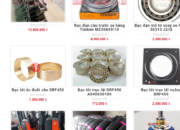Buying and using electric forklifts, diesel forklifts with a capacity of 1.5 to 10 tons, new vehicles is not cheap. Therefore, some businesses choose to buy used electric forklifts and used diesel forklifts with the same functions, which are half cheaper. But how to choose and buy a used forklift? How can it be economically efficient? requires us to have a certain knowledge of the vehicle, should choose a reputable supplier, the car has a clear origin, the car is still original (the car parts are not patchwork, replaced with drifting spare parts). famous…) choose cars of reputable brands (such as European, Japanese goods)…
Samcovina currently imports a lot of used cars in CBU form. Including old (used) electric cars, old standing electric forklifts, old diesel forklifts, old container forklifts, imported from Europe to Vietnam. With old electric forklift trucks with capacity 1 ton, 1.5 ton, 2 ton, 2.5 ton, 3 ton, 3.5 ton, 5 ton, lifting height from 0.8m to 9m. The old diesel forklift has a load capacity of 1-10 tons with a lifting height of 3m-6m. The old container forklift has a capacity of 10-45 tons. Can be used in all environments, in warehouses, workshops, in -20 degrees Celsius cold storage, container yards, ports…
For used forklifts – used forklifts, any vehicle will undergo a test to fully meet the technical and safety requirements by specialized equipment and the same team. professional engineers and technicians before putting on the market. All used forklifts of samcovina have clear origin and quality control.
We sell at a cheap price compared to the common ground in the Vietnamese market, because the cars we import and sell continuously, we cannot import all and exactly the cars available at the yard. If you have a need, please contact us for detailed advice and support.








Xin cho tôi xem hình thật và giá của một số dòng xe nâng điện, xe nâng diesel của công ty đang có hiện nay.
Cảm ơn
Vâng, cty đã gửi hình ảnh và báo giá một số dòng xe nâng điện, xe nâng diesel như yêu cầu của anh qua email rồi nhé.
Rất mong nhận được hợp tác
Cty cho tôi hỏi,
Tôi muốn xem một số dòng xe nâng điện, xe nâng diesel có tải trọng khoảng 3 đến 4 tấn.
Tôi có thể đến bãi xem xe được không?
Công ty tôi có nhu cầu mua khoảng 3 chiếc
Chào anh Cương,
Hiện tại ở bãi xe của chúng tôi loại như anh yêu cầu vẫn còn, anh có thể để lại số điện thoại hoặc gọi lại cho chúng tôi để xếp thời gian tiếp anh.
Thân mến!
Xin cho hỏi bên mình có bán phụ tùng cho xe nâng dầu Toyota không? Chúng tôi cần liền
Vui lòng phản hồi sớm
Chào bạn
Vâng bên mình có bán phụ tùng cho xe nâng, tuy anh vui lòng cho chúng tôi biết cụ thể loại phụ tùng nào mình đang cần nhé
Thanks